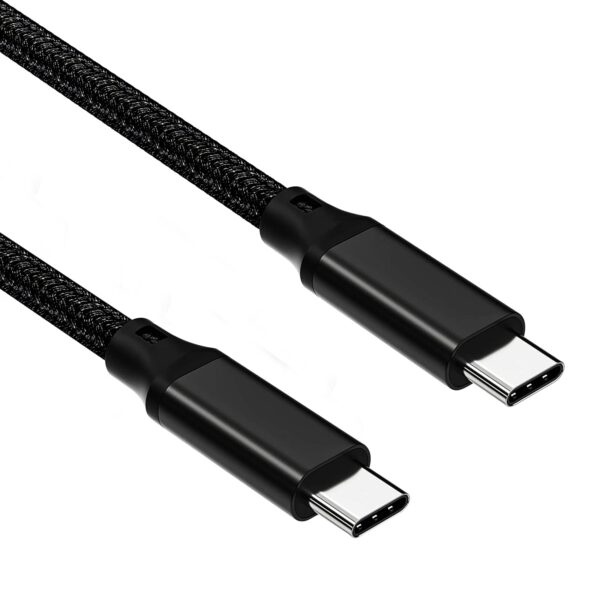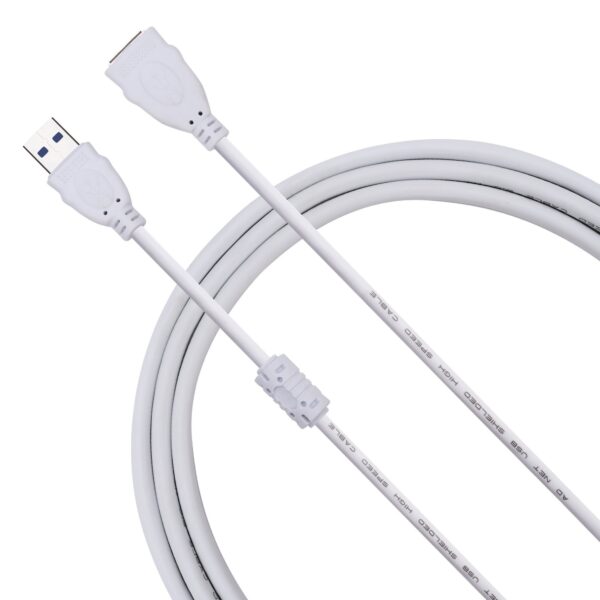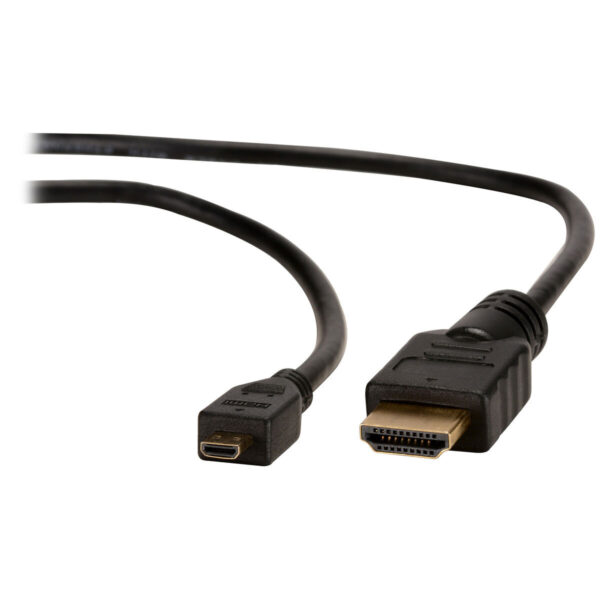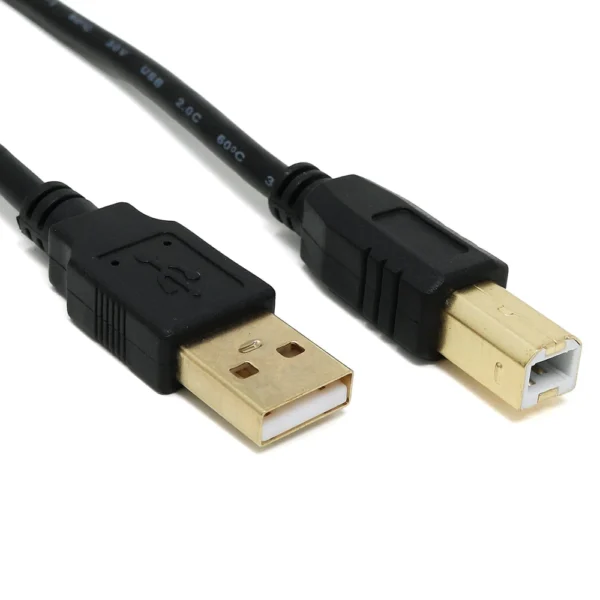| Description |
- Connects USB-B devices (e.g., printers, scanners)
- Supports USB 2.0 data transfer (up to 480 Mbps)
- Durable construction with reinforced connectors
- Available lengths: 1m to 3m (3.3ft to 10ft)
- Plug-and-play; no drivers needed
- Ideal for specialized industrial use and device communication
|
- Dual USB-C Connectors
- High-Speed Data Transfer
- Fast Charging Capabilities
- Wide Compatibility
- Various Lengths and Configurations
- Versatile Usage
|
- Extends the reach of USB connections between devices
- Available in various lengths to suit different needs
- Features USB Type-A connectors on one end and Type-A or Type-B connectors on the other
- Compatible with USB standards like USB 2.0, USB 3.0, USB 3.1, and USB 3.2
- Versatile accessory for home and professional environments
- Constructed with durable materials for reliable performance
- Easy to use, requiring no special installation or configuration
|
- Connectivity: Links Micro HDMI devices to HDMI displays.
- Compatibility: Works with Micro HDMI technology.
- Resolution Support: Supports SD, HD, and 4K resolutions.
- Audio and Video Transmission: Transmits both audio and video signals.
- Construction: Durable materials ensure reliable signal transmission.
- Length Options: Available in various lengths for different setups.
- Plug-and-Play: Simple connection without additional software.
- Versatility: Suitable for cameras, tablets, and other devices to connect to TVs, monitors, or projectors.
|
- Connects USB-A (standard rectangular) to USB-B (square/trapezoidal) connectors
- Facilitates data transfer between computers and peripherals like printers and scanners
- Can provide power for charging devices like older smartphones and tablets
- Compatible with USB standards such as USB 2.0, USB 3.0, and USB 3.1
- Available in various lengths and configurations
- Versatile accessory for home and professional setups
|
- Connectors:
- USB Type-A (Male): Rectangular, fits all USB Type-A ports
- USB Type-B (Male): Almost square, fits printers, scanners, and external hard drives
- Data Transfer Rates:
- USB 2.0: Up to 480 Mbps
- USB 3.0/3.1 Gen 1: Up to 5 Gbps
- USB 3.1 Gen 2: Up to 10 Gbps
- Lengths Available: 1 to 15 feet
- Applications:
- Connect printers, scanners, external hard drives, and audio interfaces
- Key Benefits:
- Fast and reliable data transfer
- Durable construction with EMI shielding
|
| Content | USB-B to USB-B cables are designed to connect devices with USB-B ports. These cables are typically used for connecting certain peripherals, such as printers, scanners, and other devices, to each other or to a computer with a USB-B interface.
Key Features:
- Universal Compatibility:
- USB-B End: Fits standard USB-B ports found on many older peripherals like printers, scanners, and some external hard drives.
- Data Transfer:
- Provides reliable data transfer between devices with USB-B ports.
- Typically supports data transfer rates up to USB 2.0 standard (480 Mbps).
- Durability and Build Quality:
- Constructed with high-quality materials to ensure longevity and resistance to wear and tear.
- Often features reinforced connectors and durable cable sheathing.
- Lengths and Flexibility:
- Available in various lengths to suit different setup requirements, commonly ranging from 1 meter (3.3 feet) to 3 meters (10 feet).
- Plug-and-Play:
- Easy to use with no need for additional drivers or software for most operating systems.
Typical Use Cases:
- Connecting Printers and Scanners:
- Ideal for connecting USB-B equipped printers and scanners to computers or other devices.
- Inter-Device Communication:
- Facilitates direct communication between two USB-B equipped devices.
- Specialized Applications:
- Used in some industrial and professional environments where specific devices require USB-B connections.
|
USB-C-to-USB-C cables are versatile connectors used primarily for charging and data transfer between devices with USB-C ports. Here's a description:
- Connectivity: USB-C-to-USB-C cables feature USB-C connectors on both ends. USB-C, also known as Type-C, is a reversible connector that has become increasingly popular due to its versatility and convenience. It can be plugged in either way, making it easier to use.
- Data Transfer: These cables facilitate high-speed data transfer between devices, allowing users to connect USB-C devices such as smartphones, tablets, laptops, external hard drives, and monitors to each other or to chargers and docking stations with USB-C ports.
- Power Delivery: USB-C-to-USB-C cables support power delivery, enabling fast charging for compatible devices. They can deliver higher power outputs compared to older USB standards, allowing for rapid charging of smartphones, tablets, laptops, and other USB-C devices.
- Compatibility: These cables are compatible with various USB standards, including USB 2.0, USB 3.0, USB 3.1, and USB 3.2, depending on the specific cable and the devices being connected.
- Length and Varieties: USB-C-to-USB-C cables come in various lengths and configurations to suit different needs and setups. Some may have additional features such as braided shielding for durability, gold-plated connectors for better conductivity, or USB-IF certification for compliance with industry standards.
- Versatility: USB-C-to-USB-C cables are versatile accessories that are widely used in both home and professional environments for connecting a wide range of USB-C devices to each other or to chargers and docking stations. They are essential for ensuring seamless connectivity, data transfer, and power delivery in modern USB-C ecosystems.
|
USB extension cables are accessories used to extend the reach of USB connections between devices. Here's a description:
- Extension Functionality: USB extension cables serve to extend the length of existing USB cables, providing additional reach between devices. They come in various lengths, typically ranging from a few feet to several meters, allowing users to connect USB devices over longer distances.
- Connectivity: These cables feature USB Type-A connectors on one end and USB Type-A or Type-B connectors on the other end, depending on the specific cable type and use case. They enable the extension of connections between devices such as computers, printers, scanners, keyboards, mice, external hard drives, and USB hubs.
- Compatibility: USB extension cables are compatible with various USB standards, including USB 2.0, USB 3.0, USB 3.1, and USB 3.2, depending on the specific cable and devices being connected. They maintain the data transfer and power delivery capabilities of the original USB connection.
- Versatility: These cables are versatile accessories suitable for various applications in both home and professional environments. They allow users to overcome limitations in cable length and position devices more flexibly, enhancing convenience and accessibility in USB setups.
- Design and Durability: USB extension cables are typically constructed with high-quality materials and durable connectors to ensure reliable performance and longevity. Some may feature additional shielding or gold-plated connectors for improved signal integrity and resistance to interference.
- Ease of Use: USB extension cables are easy to use, requiring no special installation or configuration. Users simply plug one end of the extension cable into the existing USB port and connect the desired device to the other end.
Overall, USB extension cables are essential accessories for extending USB connections and overcoming distance limitations in various setups, providing flexibility, convenience, and enhanced connectivity for USB-enabled devices.
| Standard Micro HDMI cables are used to connect devices with Micro HDMI outputs to displays, monitors, or other devices with compatible HDMI inputs. Here's a description of their features:
- Connectivity: Standard Micro HDMI cables provide a reliable connection between devices with Micro HDMI outputs, such as cameras, camcorders, or tablets, and displays, TVs, or projectors equipped with HDMI inputs.
- Compatibility: These cables are compatible with devices that support Micro HDMI technology, including many digital cameras, camcorders, and portable devices. They can connect to HDMI displays, TVs, or projectors from various manufacturers.
- Resolution Support: Standard Micro HDMI cables support various resolutions, including standard definition (SD), high definition (HD), and even some higher resolutions like 4K, depending on the capabilities of the connected devices.
- Audio and Video: Micro HDMI cables transmit both audio and video signals, allowing users to enjoy high-definition multimedia content on compatible HDMI displays or monitors.
- Construction: These cables are typically constructed with high-quality materials to ensure durability and reliable signal transmission. They may feature gold-plated connectors for better conductivity and resistance to corrosion.
- Length Options: Standard Micro HDMI cables are available in various lengths to accommodate different setups and distances between devices and displays.
- Plug-and-Play: They are generally plug-and-play devices, requiring no additional drivers or software installation. Users can simply plug one end of the cable into the Micro HDMI output of their device and the other end into the HDMI input of their display.
- Versatility: Standard Micro HDMI cables are versatile and can be used for various applications, including connecting cameras or camcorders to TVs or monitors for viewing photos or videos, streaming content from tablets to TVs, or extending desktop setups to larger displays.
Overall, Standard Micro HDMI cables offer a convenient and reliable solution for connecting devices with Micro HDMI outputs to HDMI displays or monitors, enabling seamless audio and video transmission for a wide range of applications. | USB-A-to-USB-B cables are commonly used for connecting various peripherals and devices to computers and other USB-equipped devices. Here's a description:
- Connectivity: USB-A-to-USB-B cables feature a USB-A connector on one end and a USB-B connector on the other. The USB-A connector is the standard rectangular connector found on computers, laptops, and USB hubs, while the USB-B connector is typically square or trapezoidal and is commonly used for printers, scanners, and other peripherals.
- Data Transfer: These cables facilitate data transfer between devices, allowing users to connect peripherals such as printers, scanners, external hard drives, and audio interfaces to their computers or other devices with USB ports.
- Power: USB-A-to-USB-B cables can also provide power to devices, making them suitable for charging certain devices like older smartphones, tablets, and some music equipment.
- Compatibility: They are compatible with various USB standards, including USB 2.0, USB 3.0, and USB 3.1, depending on the specific cable and the devices being connected.
- Length and Varieties: These cables come in various lengths and configurations to suit different needs and setups. Some may have additional features such as gold-plated connectors for better conductivity or braided shielding for improved durability and signal integrity.
- Versatility: USB-A-to-USB-B cables are versatile and widely used in both home and professional environments for connecting a range of devices to computers and other USB-enabled devices. They are essential accessories for ensuring seamless connectivity and data transfer between various peripherals and computers.
| USB-A to USB-B cable is a high-quality connection solution designed to link various peripheral devices to your computer or other host devices. This cable is particularly useful for connecting printers, scanners, external hard drives, and audio equipment.
Key Features
- Connectors
- USB Type-A Connector (Male)
- Shape: Rectangular
- Compatibility: Compatible with all USB Type-A ports
- USB Type-B Connector (Male)
- Shape: Almost square
- Compatibility: Compatible with printers, scanners, external hard drives, and other USB Type-B devices
- Data Transfer Rates
- USB 2.0: Up to 480 Mbps
- USB 3.0/3.1 Gen 1: Up to 5 Gbps
- USB 3.1 Gen 2: Up to 10 Gbps
- Power Delivery
- Provides stable and reliable power supply to devices
- Length
- Available in various lengths: from 1 foot to 15 feet
- Build Quality
- Strong and durable design
- High-quality materials with EMI shielding
|










![Charger Charging Cable Cord [USB-C, 5ft] for Logitech Wireless G733 KDA G PRO X Lightspeed](https://cableonclick.com/wp-content/uploads/2024/06/0193-USB-A-to-USB-C-Cables-04-300x400.jpg)










Rating & Review
There are no reviews yet.